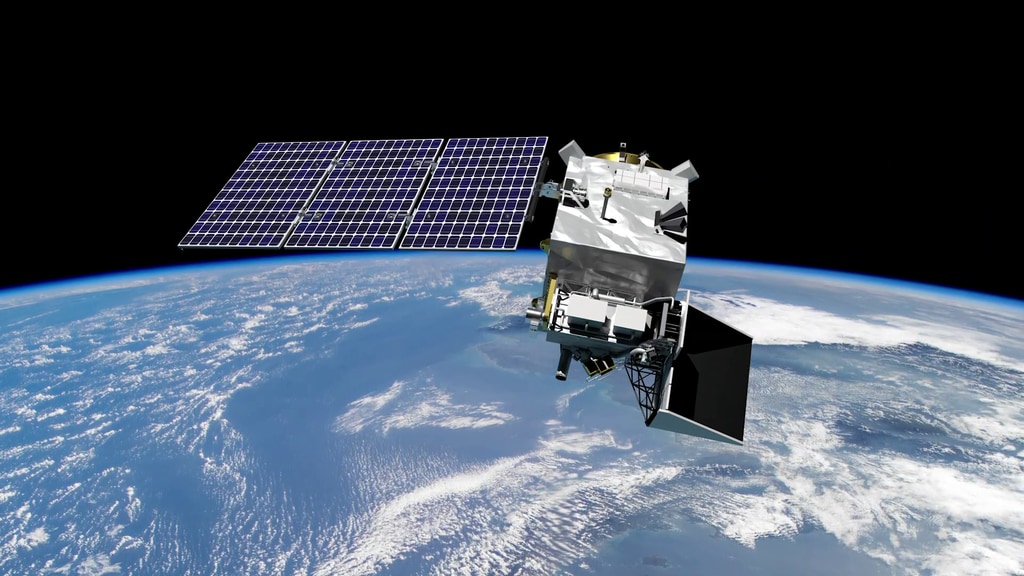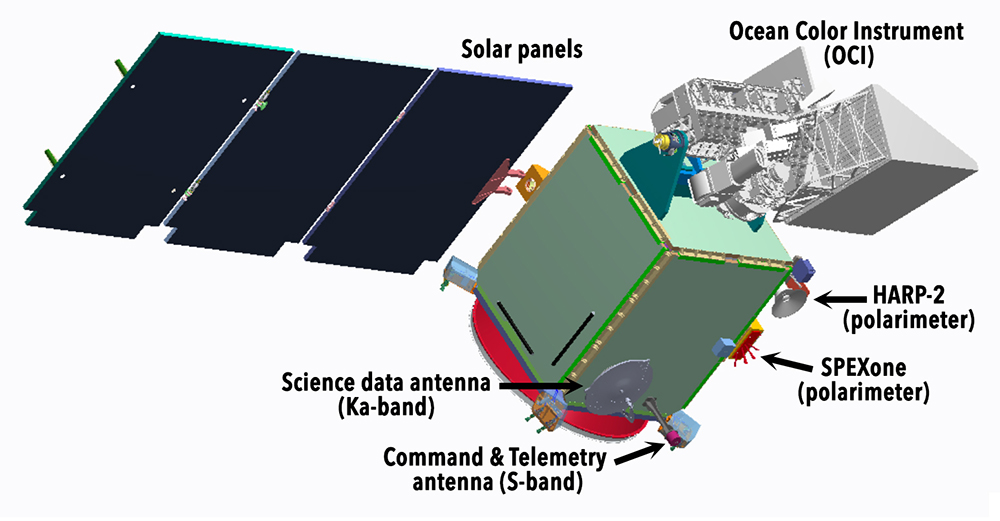Er is groen licht voor SPEXone, het nieuw te ontwikkelen Nederlandse ruimte-instrument voor aerosolmeting. Vandaag zegde het Netherlands Space Office de nog benodigde 7 miljoen euro toe voor de vervaardiging van het meetinstrument. Aan boord van NASA-satelliet PACE (lancering 2022) brengt SPEXone ongekend nauwkeurig de eigenschappen van aerosolen in de atmosfeer in kaart en geeft daarmee antwoord op grote, openstaande klimaatvragen.

‘Een van de grootste hiaten in onze kennis van het hedendaagse klimaat is dat we niet precies weten hoeveel aerosolen er in de atmosfeer zitten, welke eigenschappen die hebben en wat hun precieze effect op straling en wolkenvorming is,’ stelt Otto Hasekamp van SRON, hoofdonderzoeker voor SPEXone. Het instrument meet aerosolen—kleine stofdeeltjes in de lucht zoals roetdeeltjes, as en woestijnstof, ook wel fijnstof genoemd. Ze hebben grote invloed op luchtvervuiling en klimaatverandering, maar hun precieze rol is onvoldoende bekend. Zo weerkaatsen de meeste aerosolen licht en hebben daarmee een afkoelend effect op de aarde, maar kunnen ze door absorptie ook een opwarmend effect hebben.
Samenwerking
De ontwikkeling van SPEXone ligt in handen van een samenwerking tussen SRON Netherlands Institute for Space Research en Airbus Defence and Space Netherlands, ondersteund door experts van TNO en het Nederlandse MKB. ‘Met deze investering wordt Nederland partner in een toonaangevende NASA-missie die belangrijke vragen over klimaat adresseert,’ zegt Hasekamp.
Aerosolen onderscheiden
‘Het compacte SPEXone instrument (minder dan 10 kg, red.) geeft onderzoekers nauwkeuriger dan voorheen inzicht in de eigenschappen van aerosolen, zoals grootte, samenstelling, vorm en absorberend vermogen,’ vertelt Hasekamp. Een spectropolarimeter brengt de aerosol-eigenschappen die voor opwarming of afkoeling zorgen in kaart door te meten in hoeverre zonlicht is gepolariseerd als het via de aardatmosfeer is teruggekaatst richting de PACE-satelliet.
PACE observatorium
Het NASA-observatorium PACE (Plankton, Aerosol, Cloud & ocean Ecosystem) bestudeert verschillende factoren die in samenhang invloed hebben op klimaat. PACE herbergt drie wetenschappelijke instrumenten: hoofdinstrument OCI (Ocean Color Instrument), de aerosol-polarimeter SPEXone en de wolken-polarimeter HARP-2 (Hyper-Angular Rainbow Polarimeter).
Financiering
SPEXone is mogelijk gemaakt door een Nederlandse investering van veertien miljoen euro. Daarvan betaalde het Netherlands Space Office eerst al twee en nu nog eens zeven miljoen euro. Overige financiering komt van de Nederlandse organisatie voor Wetenschappelijk Onderzoek (NWO), SRON Netherlands Institute for Space Research en Airbus Defence and Space Netherlands. NASA verzorgt—naast het OCI instrument—de satelliet, de integratie van de instrumenten op de satelliet, de lancering en infrastructuur op de grond. Het HARP-2 instrument wordt geleverd door University of Maryland, Baltimore County (UMBC).
Tropomi
Het is niet voor het eerst dat Nederland een belangrijke leverancier is van technologie voor atmosfeermetingen vanuit de ruimte. Ook het Tropomi-instrument op de Sentinel 5 Precursor satelliet van de EU en ESA was het resultaat van een Nederlandse inspanning. De projectpartners binnen SPEXone gebruiken kennis en expertise die zij daarbij hebben opgedaan.

SPEXone is being developed by a Dutch consortium consisting of SRON Netherlands Institute for Space Research and Airbus Defence and Space Netherlands, supported by opto-mechanical expertise from TNO. SRON and Airbus DS NL are responsible for the design, manufacture and test of the instrument. The scientific lead is in the hands of SRON. SPEXone is a public-private initiative, funded by the Netherlands Space Office (NSO), the Netherlands Organization of Scientific Research (NWO), SRON and Airbus DS NL.
————————————————————————————————————-
————————————————————————————————————-
Dutch aerosol instrument on NASA Earth ecosystem satellite receives green light
The newly developed Dutch space instrument for aerosol measurement SPEXone is awarded € 7 million from the Netherlands Space Office. This completes the funding that is needed for the production of the instrument. Onboard NASA satellite PACE (launch 2022), SPEXone will map the amount and properties of aerosols with unprecedented accuracy, providing new valuable data to climate scientists.

‘One of the biggest gaps in our knowledge of the contemporary climate is that we don’t know exactly how many aerosols there are in the atmosphere, what properties they have and what their precise effect is on radiation and cloud formation,’ says Otto Hasekamp of SRON, principal investigator for SPEXone. The instrument measures aerosols—small dust particles in the air, such as soot, ash and desert dust, also known as particulates. They have a major influence on air pollution and climate change, but their precise role is insufficiently known. For example, most aerosols reflect light and have a cooling effect on the Earth, but they can also have a warming effect due to absorption.
Collaboration
SPEXone will be developed by a collaboration between SRON Netherlands Institute for Space Research and Airbus Defence and Space Netherlands, supported by experts from TNO and Dutch SME’s. ‘With this investment, The Netherlands becomes a partner in a leading NASA mission that addresses important questions about climate,’ says Hasekamp
Distinguishing aerosols
‘The compact SPEXone instrument (less than 10 kg, red.) gives researchers unprecedented insight into the properties of aerosols, such as size, composition, shape and absorbent capacity,’ says Hasekamp. The spectropolarimeter accurately maps out the properties that cause warming or cooling by measuring the extent to which sunlight is polarized when it has been reflected by the Earth’s atmosphere in the direction of the PACE satellite.
PACE observatory
The NASA observatory PACE (Plankton, Aerosol, Cloud and ocean Ecosystem) studies the various factors that affect the climate. PACE harbors three scientific instruments: main instrument OCI (Ocean Color Instrument), aerosol polarimeter SPEXone and cloud polarimeter HARP-2 (Hyper-Angular Rainbow Polarimeter).
Funding
SPEXone is made possible by a Dutch investment of 14 million euros, including investments by the Netherlands Space Office of €2 million and €7 million euros. Other funding comes from the Netherlands Organization for Scientific Research (NWO), SRON Netherlands Institute for Space Research and Airbus Defence & Space Netherlands. In addition to the OCI instrument, NASA provides the satellite, the integration of the instruments on the satellite, the launch and the infrastructure on the ground. The HARP-2 instrument is provided by University of Maryland, Baltimore County (UMBC).
Tropomi
It is not the first time that The Netherlands is an important supplier of technology for atmospheric measurements from space. The TROPOMI instrument on the Sentinel 5 Precursor satellite from the EU and ESA was also the result of a Dutch effort. The project partners within SPEXone use knowledge and expertise that they have gained from TROPOMI.

SPEXone is being developed by a Dutch consortium consisting of SRON Netherlands Institute for Space Research and Airbus Defence and Space Netherlands, supported by opto-mechanical expertise from TNO. SRON and Airbus DS NL are responsible for the design, manufacture and test of the instrument. The scientific lead is in the hands of SRON. SPEXone is a public-private initiative, funded by the Netherlands Space Office (NSO), the Netherlands Organization of Scientific Research (NWO), SRON and Airbus DS NL.


